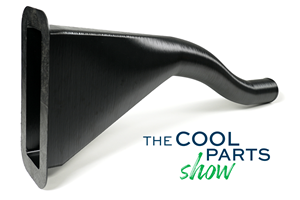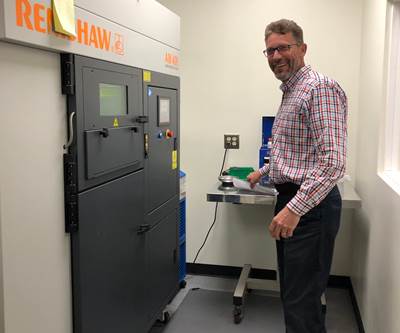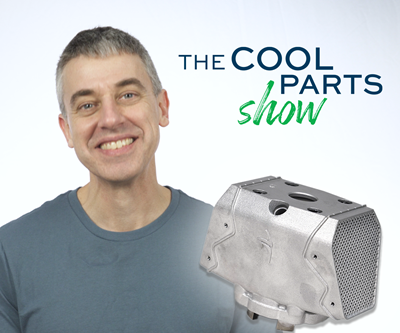Drone Engine Replaces 13 Parts With 1: The Cool Parts Show #14
Cobra Aero discovered an opportunity for redesign it might never have found without the COVID-19 interruption providing time for product development via 3D printing. The Cool Parts Show explores how additive manufacturing is advancing during the coronavirus crisis.
Share
When we first reported on Cobra Aero, we told the story of how this maker of an unmanned aerial system engine (that is, a drone engine) had redesigned the engine cylinder for metal additive manufacturing (AM). The switch from casting to 3D printing the cylinder allowed for significant improvement in engine performance. Unknown to Cobra at the time, the cylinder would not stand as the greatest win the company would see from AM. When production was interrupted because of the COVID-19 crisis, the delay gave the company's small engineering team the chance to experiment with its Renishaw AM system to see what other parts could be produced this way. As CEO Sean Hilbert describes, a redesign of the engine’s exhaust for AM consolidated 13 parts into one, removed 25% of the weight, simplified assembly, improved power efficiency and produced a quieter drone.
This episode is part of a series in which we revisit companies from past episodes to find stories of how AM is advancing in surprising ways during the coronavirus pandemic.
The Cool Parts Show is a video series from Additive Manufacturing Media that explores the what, how and why of unusual 3D printed parts. Watch more here.
Have a cool part to share? Email us.
Resources and links
- The Cool Parts Show episode on the Cobra Aero cylinder
- Cobra’s use of AM alongside CNC machining capability
- AM technology from Renishaw
Transcript
Peter Zelinski, Additive Manufacturing
Even for companies invested in additive manufacturing, it can be hard to see all the wins. This company needed the delay of a pandemic to have the chance to take a second look and discover one of its best opportunities to redesign a part for additive manufacturing. Welcome to The Cool Parts Show.
Peter Zelinski
I'm Pete.
Stephanie Hendrixson, Additive Manufacturing
I'm Stephanie.
Peter Zelinski
We are doing special episodes of The Cool Parts Show, looking back at companies and people we've looked at in past episodes.
Stephanie Hendrixson
Yeah, so we are in the midst of the coronavirus pandemic right now. So it looks like we're sitting side by side. But actually we are six feet apart. We are social distancing and we're filming all of these updates with this setup.
Peter Zelinski
Today we are checking in with Cobra Aero. Stephanie, do you remember them?
Stephanie Hendrixson
Yeah, we talked about Cobra Aero in Season 2, Episode 3, and we'll put a link in the description if you haven't seen it. But if I recall, Cobra Aero was a spin out of Cobra Moto, which is a company that makes motocross bikes. And they found that their expertise with small engines actually gives them a leg up in making drone engines. We looked at the cylinder that they had redesigned for additive manufacturing.
Peter Zelinski
During this shelter-in-place period, Cobra Aero is running with a skeleton crew. And so CEO Sean Hilbert looked for what they could do with this time, what the opportunities are, leveraging one of the strengths of their additive manufacturing capability, which is product development. They're experimenting with new product designs. Just as you said, we talked about the dramatic changes to this engine cylinder. Well, they've redesigned their exhaust system now through additive during this time and discovered even more profound product improvement.
Stephanie Hendrixson
If I recall from the cylinder episode, they were able to reduce the weight of that part. They improved its performance. The redesigned part cools better and they made it easier to manufacture. And it's only one part where there used to be two. So I imagine there's sort of similar benefits they're seeing now with the exhaust.
Peter Zelinski
Yes. Even more so. So listen to this. The redesigned exhaust system redesigned for additive, the benefits that they won. Assembly consolidation. Instead of two parts to one, they took what used to be 13 different machined parts and combined it into one. Ease of manufacturing, they were able to design it with wrench access now that it didn't have before. Greater efficiency because they designed the shape of the part around some fluid analysis of how the exhaust should flow. It's 100 grams lighter and that's off of a part that was only 400 grams to begin with. It's quieter because they've changed the design to point the exhaust in a different direction. If you don't point the exhaust down, then the drone is quieter to the people on the ground. Sean Hilbert can talk about all of that.
Sean Hilbert, Cobra Aero
That's the cylinder, the old school fin cylinder that everybody is familiar with from the earlier video. And then this part on the bottom here is the exhaust system and it's got a lot of volume, you know, it's big. As you can see from all these different pieces here, we've got different chambers that have different shapes inside those chambers that need to be machined. And then this whole system is bolted together by six bolts on the outside and everything has to be sealed. And then furthermore, it's very difficult to get installed onto the engine because we have some some pretty poor bolt access here. You know, header bolts are kind of hidden behind. And then all the bolts for connecting to the main the main part of the engine case are all hidden way down deep in there. So very, very difficult to install, difficult to make, expensive. And in the end, you know, we've had this design for four or five years now. We've been able to simplify the internals of the design so that we can get the same amount of sound output or more power. So what that says is that if we went to the next level design, we could take some volume out of it and make it a better part. With all that in mind we redesigned this little piece, which is quite a bit smaller and lighter. It's got these nice features that you see on the top here for bolt access so that when we're installing things, I don't know if I can line this up with of the camera very well. But we have a nice wrench access there. The shape of it is angled down towards the propeller so that we get less of what's called masking of the prop. So the prop can actually produce more thrust with the same amount of engine output. And then internally, you can't see any of this. But internally, we've done some very interesting things with the passageways. We have got a Helmholtz resonator inside there. We've got some expanding passageways. It's a hundred grams lighter than the than the current design. And then this little feature on top here, you can see a bolt pattern. We've actually created a sound deadening device that we can basically pull out of the muffler that allows cleaning inside. And it also allows us to do various exit types. You basically don't want the exhaust to shoot down toward the ground because that creates more noise, perceptible noise for people on the ground. But a lot of things that we were able to pull together in terms of function that we couldn't do with a machined part and then manufacturability of the part itself and also assembly of the final engine, has been improved. And then weight, 100 grams out of about 400 grams, we were able to save twenty five percent on weight with that part. So that's kind of the next thing. That's what we're doing next.
Stephanie Hendrixson
Wow. So that's a great story. Maybe even better than the one that we had in our episode. So was this exhaust redesign like a project that was already in the pipeline?
Peter Zelinski
Yeah. So that's a good question. The answer is no. They did not intend to produce this through additive. You know even for someone invested in additive capability, it can be hard to see all of additive’s potential wins. Sean, for a small business owner, he is a visionary when it comes to additive. And he's got, you know, they've got this Renishaw metal additive machine that they committed to, a big investment for their company, because he's convinced of the promise of additive. And in spite of that, he didn't necessarily see that there was such a huge opportunity for additive within this particular component. He talked about that.
Peter Zelinski
Do you believe that you were always going to do this refinement and move the exhaust into additive? Was this always going to come? And it's more like a question of this is just a chance to accelerate your way there? Or is this just a rethinking that you maybe would not have come to?
Sean Hilbert
Yeah, definitely the latter. You know, we dove into additive with a few key components in mind that we thought, oh, boy, you know, we might be able to do some neat things with the cylinder. And this was one of those things that I mentioned to you last time where we just honestly weren't sure where the next ROI was going to come from but we knew it was there somewhere. And so now that we've got, you know, got the machine sitting there, that's got us thinking in a completely different way than otherwise. So, yeah, definitely the latter.
Peter Zelinski
Oh, wow. So if this had never happened and if you'd stayed busy, like you just wouldn't have had the chance to think through all that and might have just stayed with a less efficient way to produce that component.
Sean Hilbert
Yes, for sure. Less efficient and heavier. And the other thing that I didn't mention is this exhaust is actually going to be a more powerful unit as well. So, you know, we're breaking, one of the key constraints with engine design, which has always been the tradeoff of power and sound. Right? So if you, if you plug up the exhaust system to create a quiet exhaust, you always lose power. And so there's been a lot of effort on our part to maybe not completely break that constraint but minimize the tradeoff that we have between sound and power. And we're able to eke a little more power out without having any sound detriment with this design. That's a big deal. And one of the things that we haven't done yet with this design is you could do surface treatments. Not a treatment necessarily, but imagine a surface texture that was put on, say with a piece of software like the nTopology platform. You know, you can create sound attenuation, surfaces built right into the part where you couldn't otherwise. Or it would be very difficult and expensive to machine, but essentially no more expensive to print. And that's one of the things that we're looking forward to next.
Stephanie Hendrixson
So that's neat. Like we talk about additive manufacturing as being this disruptive technology, and now here's a case where additive actually benefits from a little bit of disruption.
Peter Zelinski
Yeah. This disruption that we're all in created the context for the disruptive technology to thrive. That'll do it for this episode of The Cool Parts Show. If you have not subscribed do that now, you don't want to miss our next episode. We're going to talk about a cool part coming out of this period of time, the coronavirus crisis, but it is one of the greatest scale production wins for additive manufacturing so far. You won't want to miss it.
Stephanie Hendrixson
If you haven't seen the original Cobra episode or you want to find any of our other episodes you can find them on YouTube, at AdditiveManufacturing.Media or TheCoolPartsShow.com.
Peter Zelinski
Thank you for watching.
Related Content
Video: For 3D Printed Aircraft Structure, Machining Aids Fatigue Strength
Machining is a valuable complement to directed energy deposition, says Big Metal Additive. Topology-optimized aircraft parts illustrate the improvement in part performance from machining as the part is being built.
Read MoreAircraft Ducts 3D Printed in Composite Instead of Metal: The Cool Parts Show #68
Eaton’s new reinforced PEKK, tailored to aircraft applications, provides a cheaper and faster way to make ducts compared to formed aluminum.
Read MoreAt General Atomics, Do Unmanned Aerial Systems Reveal the Future of Aircraft Manufacturing?
The maker of the Predator and SkyGuardian remote aircraft can implement additive manufacturing more rapidly and widely than the makers of other types of planes. The role of 3D printing in current and future UAS components hints at how far AM can go to save cost and time in aircraft production and design.
Read More“Mantis” AM System for Spacecraft Uses Induction for Deposition
The metal 3D printing system melts wire without lasers. 30-foot-diameter parts are built on a rotary-feed system that eliminates the need for a large machine frame or gantry.
Read MoreRead Next
Drone Engine Maker Illustrates How Additive Manufacturing Well Suited to OEMs
This small company making small engines sees big wins from metal AM in terms of both product performance and responsiveness to the market. Here, size isn’t a factor in succeeding with AM — the application instead shows how the capability is at its best when it can serve both production and design.
Read MoreImplant Maker Increases Production: The Cool Parts Show #12
Tangible Solutions has been 3D printing more implants than ever before as hospitals get ready for the coming surge in elective surgeries. The Cool Parts Show checks in to explore how additive manufacturing is advancing during the coronavirus crisis.
Read More3D Printing Changes a Drone Engine: The Cool Parts Show #9
Cobra Aero made the engine cylinder of an unmanned aerial vehicle (UAV) both more powerful and easier to manufacture. Learn what additive manufacturing is doing for drones in this episode of The Cool Parts Show.
Read More















